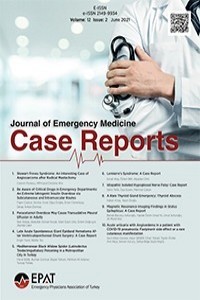Post-Travmatik Sringomiyeli
Post-travmatik sringomiyeli, vertebra kırığı, manyetik rezonans görüntüleme
Post-Traumatic Syringomyelia
___
- Barnett HJ, Jousse AT, Morley TP, Lougheed WM. Post-traumatic syringo- myelia. Paraplegia 1971; 9: 33-7. [CrossRef]
- Rossier AB, Foo D, Shillito J, Naheedy MH, Sweet WH, Dyro F, et al. Progressive late post-traumatic syringomyelia. Paraplegia 1981; 19: 96-7. [CrossRef]
- Shannon N, Symon L, Logue V, Cull D, Kang J, Kendall B. Clinical features, investigation and treatment of post-traumatic syringomyelia. J Neurol Neurosurg Psychiatry 1981; 44: 35-42. [CrossRef]
- Rossier AB, Foo D, Shillito J, Dyro FM. Posttraumatic cervical syringomy- elia. Incidence, clinical presentation, electrophysiological studies, syrinx protein and results of conservative and operative treatment. Brain 1985; 108: 439-61. [CrossRef]
- Squier MV, Lehr RP. Post-traumatic syringomyelia. J Neurol Neurosurg Psychiatry 1994; 57: 1095-8. [CrossRef]
- Vernon JD, Silver JR, Ohry A. Post-traumatic syringomyelia. Paraplegia 1982; 20: 339-64. [CrossRef]
- el Masry WS, Biyani A. Incidence, management, and outcome of post- traumatic syringomyelia. In memory of Mr Bernard Williams. J Neurol Neurosurg Psychiatry 1996; 60: 141-6. [CrossRef]
- Bleasel A, Clouston P, Dorsch N. Post-traumatic syringomyelia following uncomplicated spinal fracture. J Neurol Neurosurg Psychiatry 1991; 54: 551-3. [CrossRef]
- Aghakhani N, Baussart B, David P, Lacroix C, Benoudiba F, Tadie M, et al. Surgical treatment of posttraumatic syringomyelia. Neurosurgery 2010; 66: 1120-7. [CrossRef] 140
- Yayın Aralığı: 4
- Başlangıç: 2010
- Yayıncı: Alpay Azap
Dinitro-Ortho-Cresol Maruziyeti Sonrasında Akut Koroner Sendrom Gelişen Ardışık İki Hasta
Ahmet Oğuz BAKTIR, Hayrettin SAĞLAM, Bahadır ŞARLI, Hüseyin ARINÇ, Yasemin DOĞAN, Hüseyin KATLANDUR
Dinitro-Ortho-Cresol Maruziyeti Sonrasında Akut Koroner Sendrom Gelişen Ardışık İki Hasta
Ahmet Oğuz BAKTIR, Hayrettin SAĞLAM, Bahadır ŞARLI, Hüseyin ARINÇ, Yasemin DOĞAN, Hüseyin KATLANDUR
Amatör Futbol Oyuncusunda Anterior İnferior İliak Spine Avulsiyon Kırığı
Alper ÇIRAKLI, Eyüp Çağatay ZENGİN, Hicabi SEZGİN, Sevgi ÇIRAKLI, Murat ERDOĞAN
Trakeobronşial Yabancı Cisim Aspirasyonunda Klinik, Radyoloji ve Fizik Muayene:Hangisi Daha Önemli?
İsmail Ertuğrul GEDİK, Timuçin ALAR, Dilek ÖMÜR, Okhan AKDUR
Nurşah BAŞOL, Ufuk TAŞ, Murat AYAN, Mehmet ESEN, Muhammet ARSLAN, İlyas KOÇ, Berat ACU
Sadece Başım Ağrıyor... İzole Transvers Sinüs Ven Trombozu
Ayhan ÖZHASENEKLER, Hasan Mansur DURGUN, Ömer KAÇMAZ, İbrahim TUNÇ, Eşref AKIL, Hakan ÖNDER
Tibia ve Fibula Kırığı Olan Hastadaki Gizli Lisfranc Çıkığı
Mustafa UZKESER, Sultan Tuna Akgöl GÜR, Mesut KILIÇ, Ayhan AKÖZ, Hüseyin ŞAHİN, Mücahit EMET, Fatih ALPER
Spinal Anestezi Sonrası Gelişen Bilateral İntrakranial Subdural Hematom: Olgu Sunumu
Abdülkadir İSKENDER, Ömer AYKANAT, Hayati KANDİŞ
Amantadin İnfüzyonu Sonrası Nörolojik İyileşme
Nalan Metin AKSU, Huleyde ŞENLİKÇİ, Meltem AKKAŞ, Mehmet Mahir ÖZMEN
Yabancı Cisime Bağlı Gelişen Brakiyal A-V Fistül: Olgu Sunumu
Mehmet KOŞARGELİR, Mehmet Özgür ERDOĞAN, İsmail TAYFUR, Şahin ÇOLAK, Burcu Genç YAVUZ
